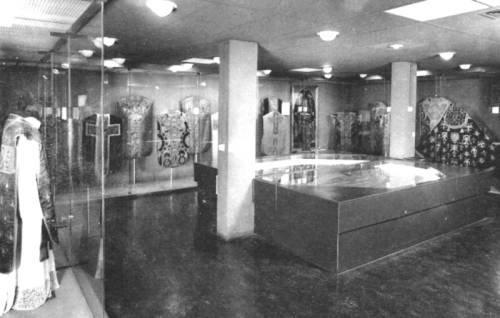
| ANNE WANNER'S Textiles in History / book reviews, articles |
Fasciculus Temporum, Arte
Tardo-medieval do Museu Nacional Het Catharijneconvent de
Utreque, by H.L.M. Defoer and W.C.M. Wüstefeld, Museu
Calouste Gulbenkian, Lisboa, 1992, Dep. Legal No 61803/92 p. 9 to 140 text and pictures in colour and black and white in portuguese language, p. 143 - 225 translation in english. This catalogue accompanied the exhibition with the same title, showed in the Gulbenkian Museum in Lisbon from 26 November 1992 to 7 February 1993 see also in french: and in dutch: |
| The management of the
Museum Calouste Gulbenkian gave an important
manuscript on loan to the exhibiton in 1989 in Utrecht
"The Golden Age of Dutch Manuscript". At the
time of the exhibition, the director of the Gulbenkian
Museum Maria Teresa Gomes Ferreira visited Utrecht and
the plan came up to show a selection of the
Catharijneconvent collection in Lisbon. In the Lisbon
exhibition Manuscripts, printed books, paintings,
ivories, sculptures and paraments with embroideries were
on show. |
In
the 16th c. the Catharijneconvent was a
monastery of the Knights of St. John.
|
Their property and buildings then came under the Estates of Utrecht. In the 19th c. the church was returned to the Roman catholics. In 1868 a fire seriousely damaged the cloister. Only in the 1960s the state authorities became interested, it resulted in the foundation of the Rijksmuseum for the History of Christian culture in the Netherlands. The buildings of the Catharijneconvent
were considered as a suitable location for the new
museum. |
 |
| In the introduction to the
catalogue part of vestments, the author explains the
difference between secular and liturgical clothing. He
also points to the specific embroidered ornamentation and
their forms on the liturgical vestment.
|
Decorative strips with
figural representations - the orphrey bands or aurifrisia
- were applied on copes, chasubles, dalmatics and
tunicles. In the 15th anbd 16th c. there was a Y-shaped or a latin cross on the front or the back side of the chasubles with embroidered representatons. |
|
|
| The technique of mediaeval
gold embroidery is explained as well: From the 13th c.
gold thread occurred in embroidery in two forms: |
Between 1425 and 1450 the
so-called couching stitch or or nué was
developped in the Southern Netherlands and it is typical
of late-medieval embroidery: Gold threads were stretched double, covering the surface to be embroidered, then caught down by coloured threads of silk. A shadow or light effect could be created by placing the stitches alternatively close together or far away from one another. |
|
details
from orphreybands with Saints, |
| Besides techniqual questions
the article also deals with the major problem of
mediaeval embroidery which is its dating and
attribution, since the makers rarely signed
their works: The design of various pieces of embroidery
has been linked by the historian Kurt Steinbart with the
work of the Amsterdam painter and woodcutter Jacob
Cornelisz. van Oostsanen (ca. 1470 - 1533). |
Names of professional
embroiderers from the Northern Netherlands occasionally
have been discovered in archives: - the name of a Peter Joosten from Amsterdam is known. In 1545 he was involved in a dispute with the church wardens of Zutphen. - the name of Arndt van Setten from Dordrecht. - in Utrecht lived the embroiderer Jacob van Malborch (died 1525).
|
| home content | Last revised April 14th, 2004 | For further information contact Anne Wanner wanner@datacomm.ch |